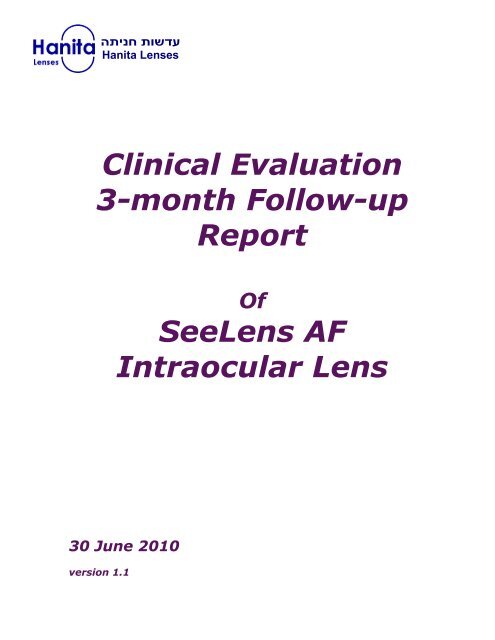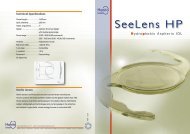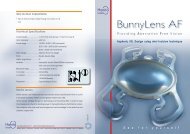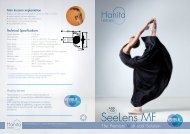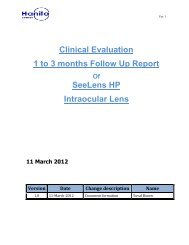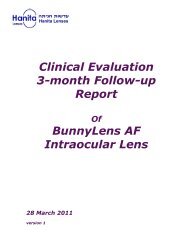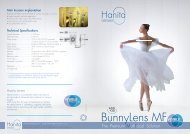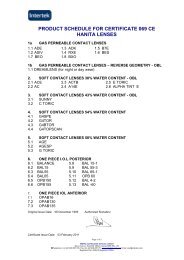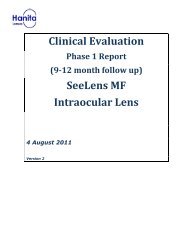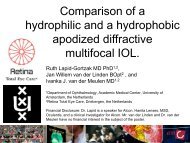Clinical Evaluation 3-month Follow-up Report SeeLens AF Intraocular Lens
SeeLens AF - Hanita Lenses
SeeLens AF - Hanita Lenses
- No tags were found...
Create successful ePaper yourself
Turn your PDF publications into a flip-book with our unique Google optimized e-Paper software.
עדשות חניתהHanita <strong>Lens</strong>es<strong>Clinical</strong> <strong>Evaluation</strong>3-<strong>month</strong> <strong>Follow</strong>-<strong>up</strong><strong>Report</strong>Of<strong>See<strong>Lens</strong></strong> <strong>AF</strong><strong>Intraocular</strong> <strong>Lens</strong>30 June 2010version 1.1
עדשות חניתהHanita <strong>Lens</strong>es1 of 21Table of Contents:Objectives 2Medical device specification and administration 4Methods 9Results 10a. IOL performance during implantation 10b. IOL position: Centration and Tilt 11c. Post-operative Best Corrected Visual Acuity 11d. <strong>Intraocular</strong> Pressure Changes 13e. Intra-operative complications 15f. Postoperative Complications 15g. Adverse Events 17h. <strong>Clinical</strong> evaluation of aspheric optics 18Conclusions 20Signature page 21Hanita <strong>Lens</strong>es <strong>Intraocular</strong> & Contact <strong>Lens</strong>eעדשות חניתהעדשות מגע ועדשות השתלה תוך-עינית•קיבוץ חניתה • 88222 www.hanitalenses.com Kibbutz Hanita 22885 Israel • Tel. 972-4-9950 700• Fax: 972-4-9950 755 •
עדשות חניתהHanita <strong>Lens</strong>es2 of 21Objectives:The objective of this study is to evaluate the safety and efficacy of the <strong>See<strong>Lens</strong></strong> <strong>AF</strong> IOL, implantedfollowing cataract removal by phacoemulsification.1. The key efficacy parameters are:- Best Corrected Visual Acuity (BCVA)2. The key safety parameters include:- IOL behavior during implantation and follow-<strong>up</strong>- IOL related infection and/or inflammatory reactionsEfficacy and Safety AssessmentsThe efficacy and safety assessments were determined as defined by and according to the ISO11979 directive. The following are the demands required by the directive:1. Post Operative BCVA of at least 6/12 (20/40) within 88% of patients' population. For the"best cases" patients, BCVA 6/12 (20/40) or better, for at least 94% of the patients.(Requirements defined by ISO 11979-7 2001 for a sample size of 100 patients).2. IOL related Post Operative complication and Adverse Events equal to or less then theallowed rate defined by ISO 11979-7 2001.3. High order aberrations / Spherical aberrations were evaluated in one medicalcenter (BEAR Institute, Berlin). Total aberrations should be statisticallysignificant lower then reported literature data for spheric lenses.Hanita <strong>Lens</strong>es <strong>Intraocular</strong> & Contact <strong>Lens</strong>eעדשות חניתהעדשות מגע ועדשות השתלה תוך-עינית•קיבוץ חניתה • 88222 www.hanitalenses.com Kibbutz Hanita 22885 Israel • Tel. 972-4-9950 700• Fax: 972-4-9950 755 •
עדשות חניתהHanita <strong>Lens</strong>es3 of 21Medical Device Specification and Administration:Specification:1. Device descriptionThe <strong>See<strong>Lens</strong></strong> <strong>AF</strong> is an aspheric asymmetric biconvex intraocular lens, which has a CE marksince 2008.<strong>See<strong>Lens</strong></strong> <strong>AF</strong> SpecificationsOptic Diameter 6.0 mmPower range+11 to +30 (0.5 increments)+30 to +40 (1.0 increments)Optic design Asymmetric Bi convex aspheric lens<strong>Lens</strong> designDouble square edge with steppedbarrierHapticangulation5ºMaterialHydrophilic Acrylic with UV andviolet blockerRefractive index 1.462 (35º c)YAG laser CompatibleA constant 119.1Placement Capsular bag or SulcusInjection –incision size2.0 mm incisionHanita <strong>Lens</strong>es <strong>Intraocular</strong> & Contact <strong>Lens</strong>eעדשות חניתהעדשות מגע ועדשות השתלה תוך-עינית•קיבוץ חניתה • 88222 www.hanitalenses.com Kibbutz Hanita 22885 Israel • Tel. 972-4-9950 700• Fax: 972-4-9950 755 •
עדשות חניתהHanita <strong>Lens</strong>es4 of 21Figure 1: <strong>See<strong>Lens</strong></strong> <strong>AF</strong> <strong>Intraocular</strong> lens2. <strong>See<strong>Lens</strong></strong> <strong>AF</strong> designa. Motivation – visual acuityHanita <strong>Lens</strong>es search for vision quality improvements has a shared objective for bothrefractive and cataract surgery. The main goal for the refractive and cataract surgery is toprovide the patient with the best visual acuity and good post operative refraction that currenttechnology allows.The quest for an improved visual acuity for the cataract patient led Hanita <strong>Lens</strong>es to developan aspheric-shaped lens, designed to allow the patient a sharper image in the regular photopicvision (daylight vision), and reduce the aberrations of mesopic and scotopic vision (twilightand night vision), which are noticed by some of the conventional spherical Intra Ocular <strong>Lens</strong>implanted patients.Figure 2:The Black line defines the photopic vision and the green line defines the scotopic vision.The area between the graphs defines the scotopic vision.Hanita <strong>Lens</strong>es <strong>Intraocular</strong> & Contact <strong>Lens</strong>eעדשות חניתהעדשות מגע ועדשות השתלה תוך-עינית•קיבוץ חניתה • 88222 www.hanitalenses.com Kibbutz Hanita 22885 Israel • Tel. 972-4-9950 700• Fax: 972-4-9950 755 •
עדשות חניתהHanita <strong>Lens</strong>es5 of 21b. Spherical aberration:The spherical aberration is a well known phenomenon in the optic field. The sphericalaberration occurs when rays of light that pass through different parts of the lens intersect atdifferent points on the optical axis of the lens (Figure 3). Due to this aberration, a dotprojected on the retina produces a larger circle, thus inducing low quality optics, an unclearvision and low contrast (Figure 4).Figure 3:Spherical AberrationFigure 4:A demonstration of the blur caused by spherical aberration with awider p<strong>up</strong>il. The rays that enter the retina from far scatter differentlyand are projected blurredly to the retina, causing a law quality image.Contributors to spherical aberration (SA) in the eye are the cornea (average +0.27 m) and thecrystalline lens (negative in the young eye). Cataract surgery removes the lens component andleaves positive SA on average. Traditional intraocular lenses (IOLs) are spherical withpositive SA, further increasing the SA of the pseudophakic eye.c. <strong>Clinical</strong> demand:As it gets darker and the p<strong>up</strong>il dilates, the spherical aberration becomes more apparent, andstarts to be noticeable by the patient. Thus patients with conventional spherical lensescomplain of unclear vision and poor contrast in the mesopic and scotopic conditions.d. <strong>Lens</strong> Design:There are three options to optimize lens surface:1) Aberration free lens- all aberrations of the eye remain.2) Reduce spherical aberration to zero (theoretically for 6mm p<strong>up</strong>ils).3) Optimize the lens surface to achieve best functional visual acuity.The <strong>See<strong>Lens</strong></strong> <strong>AF</strong> was designed using the third option: obtaining maximum ContrastSensitivity by optimizing the Modulated Transfer Function using Arizona eye model designedto match clinical levels of aberration, both on and off axis (the model is based on Navarro eyemodel and the Koojiman model and uses eye modeled for a 60 year old patient).The <strong>See<strong>Lens</strong></strong> <strong>AF</strong> optical design was performed using the symmetric aspheric surface equationdescribed below.Hanita <strong>Lens</strong>es <strong>Intraocular</strong> & Contact <strong>Lens</strong>eעדשות חניתהעדשות מגע ועדשות השתלה תוך-עינית•קיבוץ חניתה • 88222 www.hanitalenses.com Kibbutz Hanita 22885 Israel • Tel. 972-4-9950 700• Fax: 972-4-9950 755 •
עדשות חניתהHanita <strong>Lens</strong>es6 of 21C = 1/R : R – Radius of curvature.K- Conic ConstantR – Radial distance from optical axis.The theoretical asphericity value of <strong>See<strong>Lens</strong></strong> <strong>AF</strong> for 6mm p<strong>up</strong>il opening was calculated usingZEMAX simulation: IOL asphericity: -0.14µm Total Spherical Aberration of an eye: +0.13µmThis p<strong>up</strong>il opening was used to compare <strong>See<strong>Lens</strong></strong> <strong>AF</strong> with other aspheric IOLs available inthe market.Table 1 – Spherical aberrations for different aspheric IOLs, 6mm p<strong>up</strong>il opening:<strong>Lens</strong>IOLasphericity[µm]Total sphericaberration[µm]Spheric IOL +0.18 +0.45AMO Tecnis -0.27 0Alcon IQ -0.2 +0.07ReStore aspheric -0.1 +0.17Staar Afinity -0.02 +0.25B&L sofport AO 0 +0.27<strong>See<strong>Lens</strong></strong> <strong>AF</strong> -0.14 +0.13The key concept of the design was the definition of the way the eye perceives shapes underthe various conditions of contrast and luminance. The underlying principles of the concept arethe analysis of contrast vision and the MTF – The Modulated Transform Function.Optimizations of these parameters lead to the <strong>See<strong>Lens</strong></strong> <strong>AF</strong> Visual Acuity improvement.In order to confirm accurate perception of image quality by the new designed optics, the<strong>See<strong>Lens</strong></strong> <strong>AF</strong> optic design relies on the MTF (Modulation Transfer Function), the best tool forobjective quantitative measurement of visual performance and contrast sensitivity.The MTF is also an extremely sensitive measure of image quality degeneration, enabling anaccurate evaluation of the aberration degree.The <strong>See<strong>Lens</strong></strong> <strong>AF</strong> exceed the standard spherical intraocular lenses, ensuring improved qualityof image and high contrast sight sensitivity for a higher range of spatial frequencies. Thisadvantage is kept even at difficult visual situations, such as low light conditions with enlargedp<strong>up</strong>ils, or decentration of the lens. The reduction and control of spherical aberrations results ins<strong>up</strong>erior vision quality for pseudophakic patients, by providing the best image quality theretina can interpret.Hanita <strong>Lens</strong>es <strong>Intraocular</strong> & Contact <strong>Lens</strong>eעדשות חניתהעדשות מגע ועדשות השתלה תוך-עינית•קיבוץ חניתה • 88222 www.hanitalenses.com Kibbutz Hanita 22885 Israel • Tel. 972-4-9950 700• Fax: 972-4-9950 755 •
עדשות חניתהHanita <strong>Lens</strong>es7 of 21In order to provide a quantitative demonstration of the improvement in sensitivity of thecontrast of the <strong>See<strong>Lens</strong></strong> <strong>AF</strong> in comparison with the standard equal convex spherical <strong>See<strong>Lens</strong></strong> awide range of optical simulations was performed using the ZEEMAX software which is apowerful and accurate tool in optical field.Figure 5:<strong>See<strong>Lens</strong></strong> <strong>AF</strong> 5mm p<strong>up</strong>il MTF Hanita <strong>Lens</strong>es advanced optics.ZEEMAX simulation vs. spatial frequency 0-100 [Cyc/mm] .The black line defines the ideal diffraction limit of the MTF.The blue line defines the lens actual simulated performance.Figure 6:Equi-convex conventional 5mm p<strong>up</strong>il MTF spherical optics.ZEEMAX simulation MTF vs. spatial frequency 0-120[Cyc/mm].The black line defines the ideal diffraction limit of the MTF.The blue line defines the lens actual simulated performance.Figures 5 and 6 demonstrate the simulated MTF result of the lens in a dilated p<strong>up</strong>il of 5 mmwhich corresponds to the normal mydrated p<strong>up</strong>il. The <strong>See<strong>Lens</strong></strong> s<strong>up</strong>eriority isstraightforwardly noticed as the MTF decreases much faster as the spatial frequency rises inthe standard lens with respect to the <strong>See<strong>Lens</strong></strong> <strong>AF</strong> which remains very close to the MTFrefraction physical limit.e. Influence of tilt and decentrationThe <strong>See<strong>Lens</strong></strong> <strong>AF</strong> is based <strong>up</strong>on the mechanical design of <strong>See<strong>Lens</strong></strong> equi-convex spherical lens.The <strong>See<strong>Lens</strong></strong> design was proven to have good stability and good resistance to tilt andcentration as well. Moreover, the <strong>See<strong>Lens</strong></strong> <strong>AF</strong> Optical design was demonstrated by theZEEMAX to have good resilience in terms of tilt and decentration as presented in the attachedgraph.Hanita <strong>Lens</strong>es <strong>Intraocular</strong> & Contact <strong>Lens</strong>eעדשות חניתהעדשות מגע ועדשות השתלה תוך-עינית•קיבוץ חניתה • 88222 www.hanitalenses.com Kibbutz Hanita 22885 Israel • Tel. 972-4-9950 700• Fax: 972-4-9950 755 •
עדשות חניתהHanita <strong>Lens</strong>es8 of 21Figure 7: The influence of the degree of Tilt on the resultant MTFFigure 8: The influence of the degree of Tilt on the resultant MTFThe Hanita <strong>Lens</strong>es intraocular lens hydrophilic material has been in use at Hanita <strong>Lens</strong>es formore than 7 years and effectively verified its outstanding long-term behaviour in the marketin terms of biocompatibility, transparency and stability of the visual function and centration.A foldable and highly adaptable implant for all bag conformations, the <strong>See<strong>Lens</strong></strong> <strong>AF</strong> displaysoutstanding tensile strength for maximum resistance during insertion, and offer controlledunfolding for rapid visual recovery.f. Micro incision cataract surgeryAnother advantage, which is derived from the <strong>See<strong>Lens</strong></strong> <strong>AF</strong> design, is its Micro IncisionCataract Surgical (MICS) property. The <strong>See<strong>Lens</strong></strong> <strong>AF</strong> can be injected through a 2.0 mmincision. This property makes the <strong>See<strong>Lens</strong></strong> <strong>AF</strong> surgical procedure almost free of inducedsurgical cylinder to the eye.3. Surgical ProcedureThe study Surgery Procedure: cataract extraction by ECCE Phacoemolsification. Operationwas performed according to the routine surgery technique of the investigative sites.The surgical procedure was conducted according to protocol.Hanita <strong>Lens</strong>es <strong>Intraocular</strong> & Contact <strong>Lens</strong>eעדשות חניתהעדשות מגע ועדשות השתלה תוך-עינית•קיבוץ חניתה • 88222 www.hanitalenses.com Kibbutz Hanita 22885 Israel • Tel. 972-4-9950 700• Fax: 972-4-9950 755 •
עדשות חניתהHanita <strong>Lens</strong>es9 of 21Methods:The study is a prospective, open, non-randomized, multi-center study.Sample size: a multi-center study of 129 patients, who meet the inclusion / exclusion criteria for thestudy protocol across 5 centers.Protocol of the study attached as Annex A.The study was carried out starting from December 2008.The Investigative sites were:12345SiteProf. M. TetzATK Spreebogen,Berlin, GermanyDr. V. BarsodevskyNaharia Medical center,Naharia, IsraelDr. Y. TonMeir Medical center,Kfar Saba, IsraelDr. T. LiphshitzSoroka Medical center,Beer-Sheeba, IsraelDr. J. NovakRegional HospitalPradubice,Czech republicNumber ofimplanted eyesNumber of eyes3 <strong>month</strong>s follow <strong>up</strong>20 1830 2831 31*20 1828 27Total 129 122* <strong>Follow</strong> <strong>up</strong> of 2 patients was performed 2 <strong>month</strong>s post-operative instead of 3 <strong>month</strong>s.Patients Enrollment period: <strong>up</strong> to 9 <strong>month</strong>.<strong>Clinical</strong> evaluation of aspheric optics feature was performed by Prof. M. Tetz, ATK Spreebogen, Berlin,Germany. 15 patients were included in the evaluation.Statistical MethodsThe following analyses were used to describe the data in this report:1. Descriptive statistics: continuous variables are described with mean ± standard deviation(SD), median, minimum and maximum. Nominal scale variables are described withabsolute and relative (percents) frequencies. Ordinal variables are described with means ±SD and frequencies of the ordinal grades.2. Comparisons between pre and post operative variables were done with paired-samples t-test. The critical level of significance is α=0.05.3. All analyses were done using Excel 2007 statistics tool package.Hanita <strong>Lens</strong>es <strong>Intraocular</strong> & Contact <strong>Lens</strong>eעדשות חניתהעדשות מגע ועדשות השתלה תוך-עינית•קיבוץ חניתה • 88222 www.hanitalenses.com Kibbutz Hanita 22885 Israel • Tel. 972-4-9950 700• Fax: 972-4-9950 755 •
עדשות חניתהHanita <strong>Lens</strong>es11 of 21Results:a. IOL performance during implantationImplantation parameters were measured to indicate the performance of the <strong>See<strong>Lens</strong></strong> <strong>AF</strong> IOLimplantation during the standard cataract surgery. The implantation parameters that weremeasured during the implantation were <strong>See<strong>Lens</strong></strong> <strong>AF</strong> handling, folding, implantation,unfolding, need to manipulate the lens and the final centration and tilt of the lens position atthe end of the procedure.All parameters were graded on a 0 (best) to 4 (worst) scale.See Annex A for more details.The results are presented in Graph 1Graph 1: IOL performance during implantation (implantation parameters):As can be seen in graph 1, all surgeons reported that the <strong>See<strong>Lens</strong></strong> <strong>AF</strong> handling, folding andinjection are easy and smooth. IOL unfolded gently and no difficulties in IOL positioning andcentration were reported.Experienced intra-operative complications are listed in section F.Hanita <strong>Lens</strong>es <strong>Intraocular</strong> & Contact <strong>Lens</strong>eעדשות חניתהעדשות מגע ועדשות השתלה תוך-עינית•קיבוץ חניתה • 88222 www.hanitalenses.com Kibbutz Hanita 22885 Israel • Tel. 972-4-9950 700• Fax: 972-4-9950 755 •
עדשות חניתהHanita <strong>Lens</strong>es11 of 21b. IOL location and centration<strong>Lens</strong> location and centration were noted and reported in all follow-<strong>up</strong> visits. Centration andtilt were graded on a 0 (best) to 4 (worst) scale. See protocol for more details.All lenses during follow <strong>up</strong> visits including 3 <strong>month</strong>s follow-<strong>up</strong> were reported as zero (Best)centration and tilt.On top of that, on a scale of 0-4 for clarity, all lenses were reported as zero (Best).Therefore, the <strong>See<strong>Lens</strong></strong> <strong>AF</strong> demonstrated good stability and centration from implantationthroughout the 3 <strong>month</strong> follow-<strong>up</strong> period.c. Postoperative Best Corrected Visual Acuity (BCVA)Best Corrected Visual Acuity (BCVA) was reported in the pre-operative and the three <strong>month</strong>follow-<strong>up</strong> visit. Pre-operative BCVA results are shown on Graph 2, and Post-operativeBCVA results are shown on Graph 3.Graph 2: Pre-operative BCVA distribution* BCVA of 2 patients from Nahariya and Meir were not received.Hanita <strong>Lens</strong>es <strong>Intraocular</strong> & Contact <strong>Lens</strong>eעדשות חניתהעדשות מגע ועדשות השתלה תוך-עינית•קיבוץ חניתה • 88222 www.hanitalenses.com Kibbutz Hanita 22885 Israel • Tel. 972-4-9950 700• Fax: 972-4-9950 755 •
עדשות חניתהHanita <strong>Lens</strong>es12 of 21Graph 3: 3-<strong>month</strong> Post-operative BCVA distribution* BCVA of 2 patients from Meir and Soroka were not received.As shown in graph 3, postoperative (3 <strong>month</strong>s) BCVA of 6/15 or better was reported in 100%of the eyes.Pre and post-operative BCVA are compared in Table 1:Table 1: Pre-operative BCVA vs. Post-operative BCVAMesuredparameterAverageStandardDeviationPre Op BCVA 0.57 (6/10.8) 0.28Post Op BCVA 0.9 (6/6.6) 0.14Hanita <strong>Lens</strong>es <strong>Intraocular</strong> & Contact <strong>Lens</strong>eעדשות חניתהעדשות מגע ועדשות השתלה תוך-עינית•קיבוץ חניתה • 88222 www.hanitalenses.com Kibbutz Hanita 22885 Israel • Tel. 972-4-9950 700• Fax: 972-4-9950 755 •
עדשות חניתהHanita <strong>Lens</strong>es13 of 21d. <strong>Intraocular</strong> Pressure Changes:Changes in intraocular pressure (IOP) from the pre operative to 3-<strong>month</strong> postoperative visitare shown in graphs 4-5 below.Graph 4: Pre operative IOP pressure* Pre operative IOP of 2 patients from Meir and 1 from Soroka were not received.Graph 5: Post operative IOP pressure* Post operative IOP of 3 patients from Nahariya and 1 from Meir were not received.Hanita <strong>Lens</strong>es <strong>Intraocular</strong> & Contact <strong>Lens</strong>eעדשות חניתהעדשות מגע ועדשות השתלה תוך-עינית•קיבוץ חניתה • 88222 www.hanitalenses.com Kibbutz Hanita 22885 Israel • Tel. 972-4-9950 700• Fax: 972-4-9950 755 •
עדשות חניתהHanita <strong>Lens</strong>es14 of 21IOP remained within the normal range (7mmHg - 21mmHg) with in population in 100% ofthe eyes.A decrease of the intra ocular pressure was observed in the comparison of the pre operativeIOP to post operative IOP.Table 2: Pre operative IOP vs. Post operative IOPMeasuredparameterPre Op IOP[mmHg]Post Op IOP[mmHg]AverageStandardDeviation15.39 3.0313.35 2.63This decrease (mean±SD: 2.01±3.12 mmHg) was found to be statistically significant(Paired samples t-test, p
עדשות חניתהHanita <strong>Lens</strong>es15 of 21e. Intra-operative complications1. The following manipulation and damage to the IOL were reported by the surgeons:i. One injector was broken and replaced during loading of the IOL.ii. In one case during injection to the capsule, one haptic got stuck in the syringe and hadto be loosen with pincette.No damage to IOL was reported in both cases.2. The following other complications occurred during the surgery:i. One patient was found to be with small zonulysis. The IOL implantation proceededwith no problem.An implantation of an Endo Capsular Ring was required.ii. Two cases showed a peripheral scar in the inferior peripheral capsule. This was noticedprior to implantation.iii. One case showed a central opacity that could not be extracted.In these three cases, the diopter shift was 1 diopter than the intended one.f. Postoperative ComplicationsPostoperative complications, such as irritated Conjuctiva, flared anterior chamber, CornealEdema, etc., were noted and reported by the surgeons, as required in the protocol.There was no evidence of post operative infection or excessive inflammation in any of thepatients.The <strong>See<strong>Lens</strong></strong> <strong>AF</strong> is an aspheric sub-model of CE approved <strong>See<strong>Lens</strong></strong> IOL. Both IOLs have thesame geometrical design and the same dimensions, thus ensuring the same mechanicalproperties. Therefore, a slit lamp image of <strong>See<strong>Lens</strong></strong> can be used to s<strong>up</strong>port mechanicalstability of <strong>See<strong>Lens</strong></strong> <strong>AF</strong>. The <strong>See<strong>Lens</strong></strong> IOL position as seen through a slit lamp is presented inImage 1.Hanita <strong>Lens</strong>es <strong>Intraocular</strong> & Contact <strong>Lens</strong>eעדשות חניתהעדשות מגע ועדשות השתלה תוך-עינית•קיבוץ חניתה • 88222 www.hanitalenses.com Kibbutz Hanita 22885 Israel • Tel. 972-4-9950 700• Fax: 972-4-9950 755 •
עדשות חניתהHanita <strong>Lens</strong>es16 of 21Image 1: The <strong>See<strong>Lens</strong></strong> IOL as seen through a slit lamp, 3 <strong>month</strong>s post operativelyImage 1 shows that the <strong>See<strong>Lens</strong></strong> is well centered. A typical clear cornea and healthyconjunctiva can be indicated, as was seen in all <strong>See<strong>Lens</strong></strong> implants 3 <strong>month</strong>s & 1 <strong>month</strong> postoperatively. Implantation was performed by Dr. J. Novak, Regional Hospital,Pradubice,Czech republic.Hanita <strong>Lens</strong>es <strong>Intraocular</strong> & Contact <strong>Lens</strong>eעדשות חניתהעדשות מגע ועדשות השתלה תוך-עינית•קיבוץ חניתה • 88222 www.hanitalenses.com Kibbutz Hanita 22885 Israel • Tel. 972-4-9950 700• Fax: 972-4-9950 755 •
עדשות חניתהHanita <strong>Lens</strong>es17 of 21g. Adverse EventsTable 3: Adverse Events as Defined by ISO 11979-7 2001:Adverse EventCumulative:Maximal allowablerate as defined byISO 11979-7 2001 ;100 subjectsScore / measurementRate ofadverseeffectoccurred atthis studyPass/FailCystoid macular 6% No / Yes 0 % PassoedemaHyphema 5% 0 1 2 3 4 0% PassHypopyon 1% Measure in mm. 0% Pass<strong>Intraocular</strong> 1% 0% Passinfection<strong>Lens</strong> dislocation 1% Measure in mm. 0% PassP<strong>up</strong>illary block 1% No / Yes 0% PassRetinaldetachmentSecondarySurgicalintervention(eccluding retinaldetachment andposteriorcapsulotomy)1% No / Yes 0% Pass2% No / Yes, specify 0% PassPersistent:Corneal stroma 1% 0 1 2 3 4 0% PassoedemaCystoid macular 2% No / Yes 0% PassoedemaIritis 1% 0 1 2 3 4 0% PassRaised IOP req.treatment2% 0% PassAs shown in table 3, no adverse event was reported in 100% of <strong>See<strong>Lens</strong></strong> <strong>AF</strong> implanted eyes,in a sample size of 122 patients.Thus, it can be concluded that safety of <strong>See<strong>Lens</strong></strong> <strong>AF</strong> is in accordance to the ISO 11979-72001.Hanita <strong>Lens</strong>es <strong>Intraocular</strong> & Contact <strong>Lens</strong>eעדשות חניתהעדשות מגע ועדשות השתלה תוך-עינית•קיבוץ חניתה • 88222 www.hanitalenses.com Kibbutz Hanita 22885 Israel • Tel. 972-4-9950 700• Fax: 972-4-9950 755 •
עדשות חניתהHanita <strong>Lens</strong>es18 of 21i. <strong>Clinical</strong> <strong>Evaluation</strong> of Aspheric OpticsA clinical evaluation of aspheric optics feature was done using functional vision p<strong>up</strong>il. Thisevaluation is more practical than one calculated for 6 mm p<strong>up</strong>il opening described in section"Medical Device Specification and Administration", section 2.d of this report. <strong>Clinical</strong>evaluation of aspheric optics feature was performed by Prof. M. Tetz, ATK Spreebogen,Berlin, Germany. 15 patients were included in 3 <strong>month</strong>s post operative evaluation and 11patients in 6 <strong>month</strong>s post operative evaluation.The functional evaluation of SA was performed in a gro<strong>up</strong> of 15 patients using same lightconditions, 3 <strong>month</strong>s post operatively. Measured p<strong>up</strong>il size ranged from 2.7 to 4.5 withaverage of 3.51. The results are presented below. Total SA (measured using WASCA aberrometer minus): -0.01µm Average Corneal SA (measured using Pentacam): +0.26µmFunctional IOL asphericity (in the functional p<strong>up</strong>il size) was estimated to be: -0.27µm.<strong>Clinical</strong> results of <strong>See<strong>Lens</strong></strong> <strong>AF</strong> Contrast Sensitivity performance are presented in Graphs 6-7.Graphs 6-7: Contrast Sensitivity 3 and 6 <strong>month</strong>s Post OperativelyPelli-Robson Contrast sensitivity distribution between 15 patients 3 <strong>month</strong>s post operativelyis presented in graph 8.Hanita <strong>Lens</strong>es <strong>Intraocular</strong> & Contact <strong>Lens</strong>eעדשות חניתהעדשות מגע ועדשות השתלה תוך-עינית•קיבוץ חניתה • 88222 www.hanitalenses.com Kibbutz Hanita 22885 Israel • Tel. 972-4-9950 700• Fax: 972-4-9950 755 •
עדשות חניתהHanita <strong>Lens</strong>es19 of 21Graph 8: Pelli-Robson Contrast Sensitivity DistributionThe comparison of Contrast Sensitivity between <strong>See<strong>Lens</strong></strong> <strong>AF</strong> and other IOLs available in themarket is presented in Graph 9:Graph 9: Comparison of Contrast Sensitivity between Different IOLs, 3 <strong>month</strong>s postoperatively 12As can be seen in graph 9, <strong>See<strong>Lens</strong></strong> <strong>AF</strong> demonstrated excellent contrast sensitivity, similarand s<strong>up</strong>erior to some aspheric IOLs available in the market.1 Dr. Ralph Chu research as presented in the AAO Nov. 20072 <strong>Clinical</strong> Performance of New Aspheric Single-Piece IOL Design, Dr. Manfred Tetz, ASCRS, Boston 2010Hanita <strong>Lens</strong>es <strong>Intraocular</strong> & Contact <strong>Lens</strong>eעדשות חניתהעדשות מגע ועדשות השתלה תוך-עינית•קיבוץ חניתה • 88222 www.hanitalenses.com Kibbutz Hanita 22885 Israel • Tel. 972-4-9950 700• Fax: 972-4-9950 755 •
עדשות חניתהHanita <strong>Lens</strong>es21 of 21Conclusions:The detailed data from the current study on 122 eyes shows the following benefits of the<strong>See<strong>Lens</strong></strong> <strong>AF</strong> IOL: Optical performance is in accordance to ISO 11979-7 2001 requirements.Functional vision quality is similar or s<strong>up</strong>erior to other aspheric IOLs available in themarket as estimated in terms of contrast sensitivity.Very good IOL behavior during implantation as evaluated by the surgeons.Very good safety profile as reflected by: very low rate of inter and post operativecomplications and intraocular pressure changes at 3 <strong>month</strong>s.Hanita <strong>Lens</strong>es <strong>Intraocular</strong> & Contact <strong>Lens</strong>eעדשות חניתהעדשות מגע ועדשות השתלה תוך-עינית•קיבוץ חניתה • 88222 www.hanitalenses.com Kibbutz Hanita 22885 Israel • Tel. 972-4-9950 700• Fax: 972-4-9950 755 •
עדשות חניתהHanita <strong>Lens</strong>es21 of 21Signature page:Revision1.01.1Date16-June-201030-June-2010Change descriptionDocument formationData correctionNameAlex MaliarovAlex MaliarovTitleAutorHanita <strong>Lens</strong>es Executive VPR&D DirectorRA/QA VPNameAlex MaliarovDorit KelnerYakir KushlinRoni FrenkelSignatureDateHanita <strong>Lens</strong>es <strong>Intraocular</strong> & Contact <strong>Lens</strong>eעדשות חניתהעדשות מגע ועדשות השתלה תוך-עינית•קיבוץ חניתה • 88222 www.hanitalenses.com Kibbutz Hanita 22885 Israel • Tel. 972-4-9950 700• Fax: 972-4-9950 755 •


